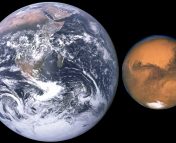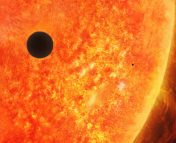
The guest post was written by Cecelia Fischer. “I am a first year Undergraduate Student at UCLA majoring in Anthropology and Arabic. In my free time I enjoy singing in my A Cappella group and exploring LA.“
Authors: Allona Vazan, Re’em Sari, Ronit Kessel
First Author’s Institutions: Astrophysics Research Center of the Open University, The Open University of Israel
In elementary school, the day when your science teacher would whip out a colorful cross section of the earth was always special. Inside that globe, there were four layers: a brown rocky crust, a red mantle, an orange outer core, and a yellow inner core. Each layer was always separate, distinctly characterized as either liquid, solid, or something in-between.
Until recently, we thought that this concept – where planetary interiors are strictly layered – was universal. Thus, we not only applied it to terrestrial earth-like planets, but also ice-rich planets such as Uranus and Neptune. In Uranus and Neptune, scientists hypothesized that an iron core was covered by a rocky mantle which was covered by an icy shell; then, that solid mass was surrounded with a gas ‘envelope’ of hydrogen and helium. Simply put, the scientific community believed that ice and rock were not mixed together, but separated.
The authors of this paper make a groundbreaking new assertion. They propose that rock and ice are not situated in separate shells or layers, but instead, mixed together in the interiors of ice-rich planets like an unappetizing slushie. To figure out why the interiors of ice-rich planets are so different from the interiors of terrestrial planets, we must dive into their material makeup. This makeup, whether it is ice or water, cosmic dirt, or rock or metal, depends mostly upon where the planet was formed in relation to the star it orbits around. Specifically for water, whether it appears as liquid, ice, or gas depends on where it was formed relative to the snow line. The snow line is like a state boundary in that it is metaphorical, but makes an important distinction. Outside of the “line”, the atmosphere is cold enough that liquids turn into solids. For example, since Uranus and Neptune are found outside of the line, they have ice instead of water.

So, to find how ice and rock actually interact in planets such as Uranus, the authors called upon previous experiments within the astrophysics community. Several studies investigated how ice-rock interactions in the interior of planets are affected by different pressures and temperatures. The end goal of these experiments was to determine what combination of temperature and pressure it would take to get ice and rock to mix. Just like the magma in a volcano needs to be both hot and forceful to trigger an eruption, the interior of a planet must be cold and pressurized enough to cause interior mixing. In Figure 1 below, the perfect combination of pressure and temperature for mixing is referred to as the SCP, the Second Critical End Point. The Figure shows that Earth and Jupiter are mainly in the complete ice–rock mixture regime. However, while Jupiter probably formed in the exterior of the ice line and thus is ice-rich, Earth is ice-poor.

To apply the SCP data to ice-rich planets and Uranus and Neptune, the authors concocted two different possible models for what ice-rich interiors could look like. Even though they were both bound to be slushies, scientists were unsure of how the ice-rock slushie would mix with the gas. The first model considers an internal structure with the slushie gradually distributed throughout – like a latte with where milk gradually lightens the espresso. The second model considers a structure where there is a clear distinction between the slushie and gas envelope, much like a tootsie pop.

Before coming to a final conclusion, the authors also considered how the temperature of the planets may evolve over time. Just as a stick of butter softens on a hot summer day, planets may change structure over the billions of years that they exist. This process is called thermal evolution. Thermal evolution is important to consider since it might change how the planets interact with temperature on the above diagram. Citing previous thermal evolution studies, the authors find that ice and rock do, in fact, stay mixed despite years of temperature shifts.
Thus, the final results show that in both gradual distribution (latte) and core-envelope (tootsie pop) models of ice-rich planets, ice and rock at high pressures will remain mixed for billions of years.
Importantly, this discovery can inform future discoveries about ice-rich planets in our solar system and beyond. In fact, shortly after this paper was released, the National Academies of Science, Engineering, and Medicine urged NASA to schedule a mission to our light-blue, largely-unexplored neighbor, Uranus. Excitingly, this mission would investigate Uranus’ numerous moons, many of which may contain oceans. If they contain oceans, they might contain liquid water … and what does that mean? Life!
Astrobite edited by Sabina Sagynbayeva
Featured Image Credit: https://recipes.timesofindia.com/us/beverage/non-alcoholic/mocha-slush/rs53975980.cms




